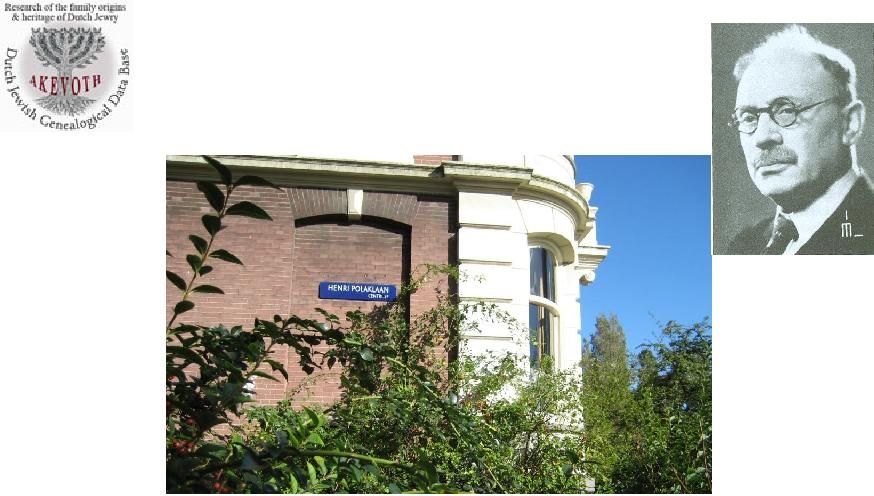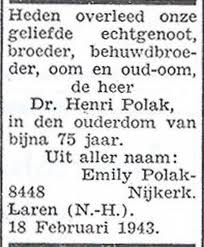Henri Polak
(22.2.1868 - 18.2.1943)
Source:
Internet and various sources
Henri Polak was a prominent Dutch socialist leader and politician. He was the eldest son in a family of ten children. His parents, Mozes Polak and Marianna Smit, got married in 1867. They were the offspring of simple Jewish people. Not all of them could read or write. In the course of the years the situation of the family improved, socially and financially. Henri's maternal grandfather became a known merchant of old books, and even enjoyed success in fencing.
Henri's father started as a diamond cutter and later on became a jeweller.
Henri was born on the Botermarkt (Rembrandtplein) located in the poor Jewish neighbourhood.
He went to the Jewish primary school in the Rapenburgerstraat, which was a good school for children from the middle classes, where he became a good pupil. Later on he learned French and English.
He tried to leave the narrow atmosphere of the neighbourhood where he grew up. He became a diamond cutter, probably because he wanted to follow his father's footsteps in the jewellery trade. He became an excellent craftsman during his employment with the jeweller Andries van Wezel.
Several of Henri's brothers were diamond traders. One of them became active in socialist circles. Henri became gradually convinced that the social circumstances of the working man had to be improved.
In 1887 Henri went to London, where he was employed as a diamond cutter by the firm Citroen. In England he met Emily Nijkerk (1868-1943), whom he married in Amsterdam in 1888.
The diamond industry in Amsterdam was an important occupation and the social standard of the Polak family steadily improved.
When Henri returned to Amsterdam, he was inspired by socialistic ideals, striving to improve the material and cultural situation of the working classes. He became one of the founders of the SDAP, the Sociaal Democratische Arbeiders Partij and dedicated much time to the founding of the NVV, the Nederlandse Vereniging van Vakbonden. He became the first chairman of this association (1905-1908).
As one of the founders of the SDAP, he fulfilled several functions in this party.
He also founded the trade union of musicians, the Amsterdamse Toon-kunstenaars Vereniging.
Afterwards he initiated the founding of the famous ANDB, the Algemene Nederlandsche Diamantbewerkers Bond, the association he directed many years. He also was the editor of the Bond's magazine. The ANDB counted 10.000 members and was known all over the country. The eight hour working day was introduced, with a yearly (unpaid) vacation of one week.
Henri remained the leader of the NVV, which was fused with the
Nederlandse Katholieke Vakverbond. The new organization became the FNV, the Federatie of the Nederlandse Vakbeweging.
Henri also became chairman of the Wereldverbond van Diamant Bewerkers, in which function he played a role outside Dutch borders.
As chairman of the SDAP he became an alderman in the Amsterdam council, and later on he held this function in Laren.
In 1913 he became a member of parliament, and was appointed a candidate minister of agriculture.
He was convinced that the working man was entitled to a decent living and to a cultural background.
The ANDB created a social department, which organized courses and he initiated an excellent library and a monthly magazine, The Young Live,
specially intended for the young diamond workers.
The publication attracted contributions from famous Dutch intellectuals.
In 1910 he founded the Centrale Commissie van Arbeidersontwikkeling, which, later on, became theInstituut voor Arbeidersontwikkeling.
During the thirties Henri fought anti-Semitism and Fascism. The extreme attitude towards Jews and Jewry in Europe, worried him very much.
Sometime after the German invasion of the Netherlands he was arrested and held prisoner, first in prison and then by a NSB member, living in Wassenaar.The NSB movement cooperated with the German invaders.
After this war episode he returned to Laren, where he died from pneumonia in 1943. He was almost 75 years old.
He was buried in Muiderberg. Many friends, most of them not Jewish, attended his funeral. His wife, Emily Polak-Nijkerk, died in Westerbork in May 1943.
Two more issues were dear to Henri Polak: Nature reservation and the improvement of the Dutch language. He was a board member of the Heemschut association and was active in several other foundations, like
The Hollandse Molen, the Vereniging tot Behoud van Natuurmonumenten and the Centrale Schoonheidscommissie in het Gooi.
He also directed several publications on the so calledMillieu.
The Gemeente Universiteit van Amsterdam honored him with an honorary doctorate in 1932, for his cultural activities.
English equivalents of institutes and organizations mentioned:-
Sociaal Democratische Arbeiders Partij - Social Democratic Workers' Party
Nederlandse Vereniging van Vakbonden -Dutch Association of Trade Unions
Algemene Nederlandsche Diamantbewerkers Bond - General Dutch Association of Diamond Workers
Amsterdamse Toon-kunstenaars Vereniging - Amsterdam Music Artists Society
Nederlandse Katholieke Vakverbond -Catholic Trade Union in the Netherlands
Federatie of theNederlandse Vakbeweging - Federation of the Trade Union movement in the Netherlands
Wereldverbond van Diamant Bewerkers -World League of Diamond Workers
Centrale Commissie van Arbeidersontwikkeling - The Central Commission for cultural development of the laborers
Institute voor Arbeidersontwikkeling - The Institute for cultural development of the laborers
Heemschut association - Association for conservation of cultural heritage
The Hollandse Molen - The Dutch Windmill
Vereniging tot Behoud van Natuurmonumenten - Association for the conservation of nature monuments
Centrale Schoonheidscommissie in het Gooi - Central Commission for the upkeep of the beauty of the Gooi region
Composed from the sources:Yael Benlev-de Jong
Translated from Dutch:Mechel Jamenfeld
Editing:Ben Noach
Final editing:Hanneke Noach
Photos:www.google.nl-afbeeldingen
(with source references mentioned there)



